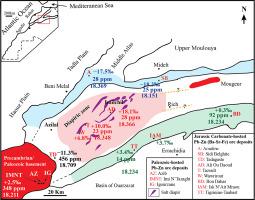Journal of Geochemical Exploration ( IF 3.4 ) Pub Date : 2021-03-10 , DOI: 10.1016/j.gexplo.2021.106765 Larbi Rddad , El Mostafa Mouguina

|
The Moroccan High Atlas metallogenic province hosts numerous Pb Zn (Ba-Sr-Fe) ore deposits hosted in the Jurassic carbonates. The high Atlas basin was formed during the Triassic-Jurassic rifting and underwent a Cenozoic tectonic inversion during the Alpine orogeny. This work presents a study of Pb and S isotopes of ore sulfides (galena, sphalerite, pyrite) from the Central and Oriental High Atlas of Morocco (CHA, OHA). The investigated ore deposits are Mississippi Valley-type (MVT) ore deposits with a simple paragenesis consisting of galena and sphalerite with subordinate barite, celestine, and pyrite. These ore deposits belong to three geographic zones; the northern border zone (NZ), the southern border (SZ), the central zone also called the diapiric zone (CZ), and the western zone (WZ) in the High Atlas. Based on the sulfur isotopic data, we suggest the Triassic-Jurassic sulfates and/or coeval pore water sulfates as the source of sulfur. Sulfur isotope compositions (δ34S = −18.6 to 22.2‰) are regionally zoned with isotopically heavy δ34S (14.3‰) in the center of the basin, negative δ34S values at the northern border (−16.9‰) and western border (−9.1‰), and intermediate δ34S values (4.4‰) at the southern border. This δ34S zonation suggests different sulfate reduction mechanisms; a low-temperature bacterial sulfate reduction (BSR) that induced the negative δ34S values and a high-temperature thermochemical sulfate reduction (TSR) that yielded positive δ34S values. The intermediate sulfur isotopic composition reflects the mixing of the TSR- derived sulfur and the bacteriogenic sulfur. The western part of the High Atlas near the Precambrian-Paleozoic paleohigh is characteristically more radiogenic (206Pb/204Pb = 18.709 207Pb/204Pb = 15.658 and 208Pb/204Pb = 38.808) than the rest of the basin (206Pb/204Pb = 18.151 to 18.369, 207Pb/204Pb = 15.631 to 15.668 and 208Pb/204Pb = 38.433 to 38.555). The Paleozoic rocks are the primary source of lead and by inference other metals. The metallogenic zone CZ with heavy sulfur isotopic composition and abundant Triassic evaporites (diapiric zone) constitutes a potential zone for future ore exploration. The SZ is also a promising target for ore exploration since it hosts ore sulfides that contain the thermally reduced sulfur (TSR).
Zn (Ba-Sr-Fe) ore deposits hosted in the Jurassic carbonates. The high Atlas basin was formed during the Triassic-Jurassic rifting and underwent a Cenozoic tectonic inversion during the Alpine orogeny. This work presents a study of Pb and S isotopes of ore sulfides (galena, sphalerite, pyrite) from the Central and Oriental High Atlas of Morocco (CHA, OHA). The investigated ore deposits are Mississippi Valley-type (MVT) ore deposits with a simple paragenesis consisting of galena and sphalerite with subordinate barite, celestine, and pyrite. These ore deposits belong to three geographic zones; the northern border zone (NZ), the southern border (SZ), the central zone also called the diapiric zone (CZ), and the western zone (WZ) in the High Atlas. Based on the sulfur isotopic data, we suggest the Triassic-Jurassic sulfates and/or coeval pore water sulfates as the source of sulfur. Sulfur isotope compositions (δ34S = −18.6 to 22.2‰) are regionally zoned with isotopically heavy δ34S (14.3‰) in the center of the basin, negative δ34S values at the northern border (−16.9‰) and western border (−9.1‰), and intermediate δ34S values (4.4‰) at the southern border. This δ34S zonation suggests different sulfate reduction mechanisms; a low-temperature bacterial sulfate reduction (BSR) that induced the negative δ34S values and a high-temperature thermochemical sulfate reduction (TSR) that yielded positive δ34S values. The intermediate sulfur isotopic composition reflects the mixing of the TSR- derived sulfur and the bacteriogenic sulfur. The western part of the High Atlas near the Precambrian-Paleozoic paleohigh is characteristically more radiogenic (206Pb/204Pb = 18.709 207Pb/204Pb = 15.658 and 208Pb/204Pb = 38.808) than the rest of the basin (206Pb/204Pb = 18.151 to 18.369, 207Pb/204Pb = 15.631 to 15.668 and 208Pb/204Pb = 38.433 to 38.555). The Paleozoic rocks are the primary source of lead and by inference other metals. The metallogenic zone CZ with heavy sulfur isotopic composition and abundant Triassic evaporites (diapiric zone) constitutes a potential zone for future ore exploration. The SZ is also a promising target for ore exploration since it hosts ore sulfides that contain the thermally reduced sulfur (TSR).
中文翻译:

摩洛哥高阿特拉斯密西西比河谷型矿石省的矿石硫化物的硫和铅同位素组成及采矿的经济潜力
摩洛哥高阿特拉斯成矿省拥有大量铅 侏罗纪碳酸盐岩中的锌(Ba-Sr-Fe)矿床。在三叠纪-侏罗纪裂谷期间形成了高位的阿特拉斯盆地,并在高山造山过程中经历了新生代的构造反转。这项工作提出了对来自摩洛哥中部和东方高等地图集(CHA,OHA)的矿石硫化物(方铅矿,闪锌矿,黄铁矿)的Pb和S同位素的研究。被调查的矿床是密西西比河谷型(MVT)矿床,具有简单的共生作用,包括方铅矿和闪锌矿以及从属重晶石,天青石和黄铁矿。这些矿床属于三个地理区域。高地图集中的北部边界区域(NZ),南部边界(SZ),中央区域(也称为二尖齿区域(CZ)和西部区域(WZ))。根据硫同位素数据,我们建议使用三叠纪-侏罗纪硫酸盐和/或同年龄的孔隙水硫酸盐作为硫的来源。硫同位素组成(δ34 S = -18.6至22.2‰)的区域划与同位素重δ 34在盆的中心S(14.3‰),负δ 34个在北部边界的价值观(-16.9‰)和西部边界(-9.1‰ ),以及中间δ 34在南部边界的价值观(4.4‰)。这个δ 34小号区划表明不同硫酸盐还原机制; 低温细菌硫酸盐还原(BSR),其感应出的负δ 34个价值观和高温热化学硫酸盐还原(TSR),其产生了积极的δ 34S值。中间硫同位素组成反映了TSR衍生硫与细菌硫的混合。与前盆地的其他部分(206 Pb )相比,高地图集的西部在前寒武纪-古生代古隆起附近具有更高的放射源性(206 Pb / 204 Pb = 18.709 207 Pb / 204 Pb = 15.658和208 Pb / 204 Pb = 38.808)。/ 204 PB = 18.151到18.369,207的Pb / 204 PB = 15.631到15.668和208的Pb / 204Pb = 38.433至38.555)。古生代岩石是铅和其他金属的主要来源。硫同位素组成重,三叠纪蒸发岩丰富的成矿带CZ(成岩带)构成了未来矿石勘探的潜在带。SZ也是矿石勘探的一个有前途的目标,因为它蕴藏着含有热还原硫(TSR)的硫化矿。
侏罗纪碳酸盐岩中的锌(Ba-Sr-Fe)矿床。在三叠纪-侏罗纪裂谷期间形成了高位的阿特拉斯盆地,并在高山造山过程中经历了新生代的构造反转。这项工作提出了对来自摩洛哥中部和东方高等地图集(CHA,OHA)的矿石硫化物(方铅矿,闪锌矿,黄铁矿)的Pb和S同位素的研究。被调查的矿床是密西西比河谷型(MVT)矿床,具有简单的共生作用,包括方铅矿和闪锌矿以及从属重晶石,天青石和黄铁矿。这些矿床属于三个地理区域。高地图集中的北部边界区域(NZ),南部边界(SZ),中央区域(也称为二尖齿区域(CZ)和西部区域(WZ))。根据硫同位素数据,我们建议使用三叠纪-侏罗纪硫酸盐和/或同年龄的孔隙水硫酸盐作为硫的来源。硫同位素组成(δ34 S = -18.6至22.2‰)的区域划与同位素重δ 34在盆的中心S(14.3‰),负δ 34个在北部边界的价值观(-16.9‰)和西部边界(-9.1‰ ),以及中间δ 34在南部边界的价值观(4.4‰)。这个δ 34小号区划表明不同硫酸盐还原机制; 低温细菌硫酸盐还原(BSR),其感应出的负δ 34个价值观和高温热化学硫酸盐还原(TSR),其产生了积极的δ 34S值。中间硫同位素组成反映了TSR衍生硫与细菌硫的混合。与前盆地的其他部分(206 Pb )相比,高地图集的西部在前寒武纪-古生代古隆起附近具有更高的放射源性(206 Pb / 204 Pb = 18.709 207 Pb / 204 Pb = 15.658和208 Pb / 204 Pb = 38.808)。/ 204 PB = 18.151到18.369,207的Pb / 204 PB = 15.631到15.668和208的Pb / 204Pb = 38.433至38.555)。古生代岩石是铅和其他金属的主要来源。硫同位素组成重,三叠纪蒸发岩丰富的成矿带CZ(成岩带)构成了未来矿石勘探的潜在带。SZ也是矿石勘探的一个有前途的目标,因为它蕴藏着含有热还原硫(TSR)的硫化矿。











































 京公网安备 11010802027423号
京公网安备 11010802027423号